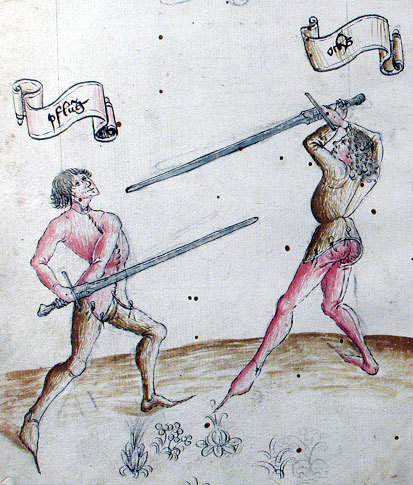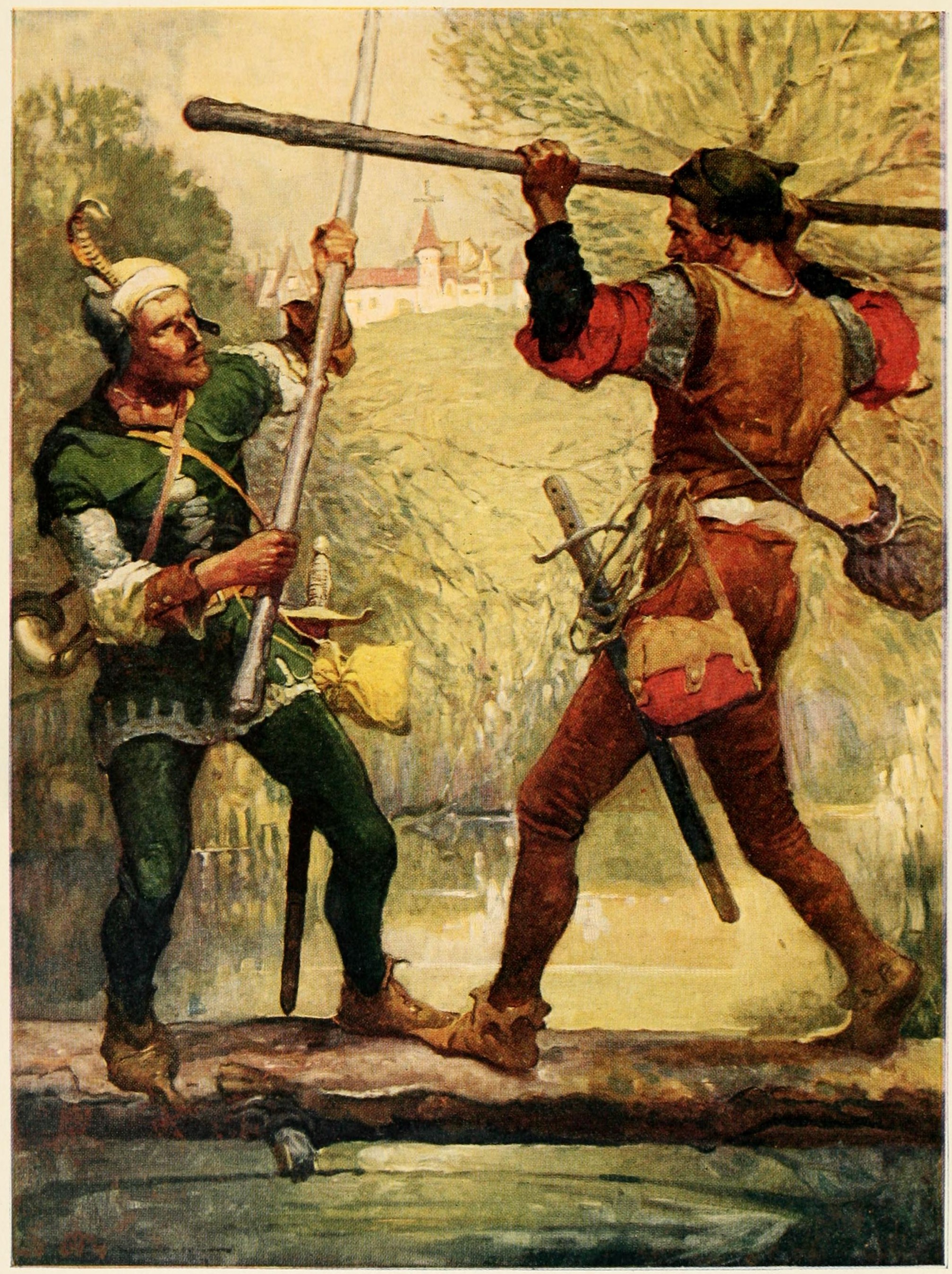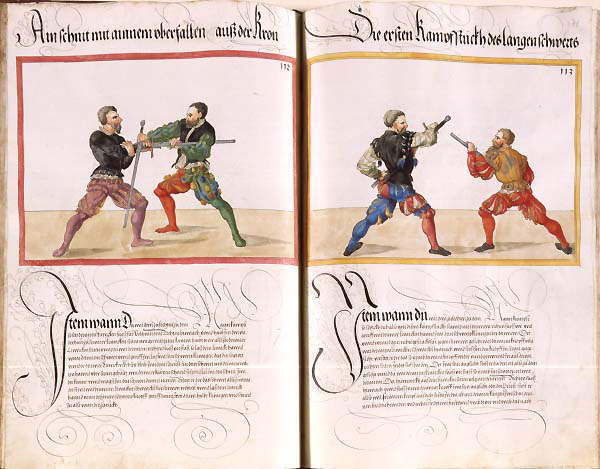|
Marxbrüder
The Brotherhood of Saint Mark (german: Marxbrüder, Marx brothers) was the name of the most important organization of German swordsmen in the 16th century. History The brotherhood originated in the 15th century, but it is not known when exactly it was founded. Hans Talhoffer may have been an early member, or even one of the founders (the lion of St Mark appears in his coat of arms in a manuscript of 1459). The earliest certain attestation dates to 1474. The group held an annual meeting in Frankfurt, where they elected their captain (''Hauptmann''). In 1487, Frederick III granted them the monopoly on the title "master of the long sword" (''Meister des langen Schwerts''), effectively making them a fencers' guild. This title was relevant for the Landsknechts, because a certified "master of the long sword" wielding the Zweihänder was entitled to twice the pay of a normal soldier (Doppelsöldner). The earliest reference to the brotherhood calls them the brotherhood of Our de ... [...More Info...] [...Related Items...] OR: [Wikipedia] [Google] [Baidu] |
German School Of Swordsmanship
The German school of fencing (') is a system of combat taught in the Holy Roman Empire during the Late Middle Ages, Late Medieval, German Renaissance, and Early Modern periods. It is described in the contemporary Fechtbuch, Fechtbücher ("fencing books") written at the time. The geographical center of this tradition was in what is now Southern Germany including Augsburg, Frankfurt, and Nuremberg. During the period in which it was taught, it was known as the ', or the ''"Art of Fighting"''. The German school of fencing focuses primarily on the use of the two-handed longsword; it also describes the use of many other weapons, including polearms, medieval daggers, Messer (weapon), messers (with or without a buckler), and the stick fighting, staff, as well as describing mounted combat and unarmed grappling (''ringen''). Most authors of writings on the system are, or claim to be, in the tradition of the 14th-century master Johannes Liechtenauer. The earliest surviving treatise on Li ... [...More Info...] [...Related Items...] OR: [Wikipedia] [Google] [Baidu] |
Federfechter Wappen
The ''Freifechter'' or ''Federfechter'' (''Freifechter von der Feder zum Greifenfels'') were a fencing guild founded around 1570 in Prague. They were known, from early in their existence, to be skilled, rivalling the Marx brothers who for the best part of a century had held a monopoly. In 1575 they were admitted by the council of Frankfurt in spite of the Marx brothers's protests, and on 7 March 1607, they were officially recognised by Rudolf II, although they had been acknowledged to be equally capable long before. While ''Freifechter'' means "free fencer" (c.f. "free lancer"), the reference to "feather" (''Feder'') in the full name of the guild is unclear, though it is believed that it was derived from the name of Saint Vitus, who is often depicted with a feather. In their ''Deutsches Wörterbuch'', the Brothers Grimm hold it plausible that it derives from the custom of pinning feathers to one's hat or lance, but the coat of arms accorded to the brotherhood by Rudolf II displays ... [...More Info...] [...Related Items...] OR: [Wikipedia] [Google] [Baidu] |
Hans Talhoffer
Hans Talhoffer (Dalhover, Talhouer, Thalhoffer, Talhofer; – after 1482) was a German fencing master. His martial lineage is unknown, but his writings make it clear that he had some connection to the tradition of Johannes Liechtenauer, the grand master of a well-known Medieval German school of fencing. Talhoffer was a well-educated man who took interest in astrology, mathematics, onomastics, and the auctoritas and the ratio. He authored at least five fencing manuals during the course of his career, and appears to have made his living teaching, including training people for trial by combat. Life The first known reference to Talhoffer is in 1433, when he represented Johann II von Reisberg, archbishop of Salzburg, before the Vehmic court. Shortly thereafter in 1434, Talhoffer was arrested and questioned by order of Wilhelm von Villach (a footman to Albrecht III von Wittelsbach, duke of Bavaria) in connection to the trial of a Nuremberg aristocrat named Jacob Auer, accused o ... [...More Info...] [...Related Items...] OR: [Wikipedia] [Google] [Baidu] |
Federfechter
The ''Freifechter'' or ''Federfechter'' (''Freifechter von der Feder zum Greifenfels'') were a fencing guild founded around 1570 in Prague. They were known, from early in their existence, to be skilled, rivalling the Marx brothers who for the best part of a century had held a monopoly. In 1575 they were admitted by the council of Frankfurt in spite of the Marx brothers's protests, and on 7 March 1607, they were officially recognised by Rudolf II, although they had been acknowledged to be equally capable long before. While ''Freifechter'' means "free fencer" (c.f. "free lancer"), the reference to "feather" (''Feder'') in the full name of the guild is unclear, though it is believed that it was derived from the name of Saint Vitus, who is often depicted with a feather. In their '' Deutsches Wörterbuch'', the Brothers Grimm hold it plausible that it derives from the custom of pinning feathers to one's hat or lance, but the coat of arms accorded to the brotherhood by Rudolf II displays ... [...More Info...] [...Related Items...] OR: [Wikipedia] [Google] [Baidu] |
Quarterstaff
A quarterstaff (plural quarterstaffs or quarterstaves), also short staff or simply staff is a traditional European pole weapon, which was especially prominent in England during the Early Modern period. The term is generally accepted to refer to a shaft of hardwood from long, sometimes with a metal tip, ferrule, or spike at one or both ends. The term "short staff" compares this to the "long staff" based on the pike with a length in excess of . The height of the staff should be around the same as the user plus their hand set upright on their head (approximately ). Etymology The name "quarterstaff" is first attested in the mid-16th century. The "quarter" possibly refers to the means of production, the staff being made from quartersawn hardwood (as opposed to a staff of lower quality made from conventionally sawn lumber or from a tree branch).OED; The possibility that the name derives from the way the staff is held, the right hand grasping it one-quarter of the distance from the ... [...More Info...] [...Related Items...] OR: [Wikipedia] [Google] [Baidu] |
Paulus Hector Mair
Paulus Hector Mair (1517–1579) was a German civil servant fencing master from Augsburg. He collected Fechtbücher and undertook to compile all knowledge of the art of fencing in a compendium surpassing all earlier books. For this, he engaged the painter Jörg Breu the Younger, as well as two experienced fencers, whom he charged with perfecting the techniques before they were painted. The project was very costly, taking a full four years, and according to Mair, consumed most of his family's income and property. Three versions of his compilation, and one later, less extensive manuscript, have been preserved. Not only did Mair spend huge sums on his collections and on his projects, he also had a very expensive lifestyle, frequently hosting receptions for the more important burghers of Augsburg. His own income was not sufficient for this, and during many years, he misappropriated funds from the city treasury, with the supervision of which he had been entrusted since 1541. His embezz ... [...More Info...] [...Related Items...] OR: [Wikipedia] [Google] [Baidu] |
Nuremberg
Nuremberg ( ; german: link=no, Nürnberg ; in the local East Franconian dialect: ''Nämberch'' ) is the second-largest city of the German state of Bavaria after its capital Munich, and its 518,370 (2019) inhabitants make it the 14th-largest city in Germany. On the Pegnitz River (from its confluence with the Rednitz in Fürth onwards: Regnitz, a tributary of the River Main) and the Rhine–Main–Danube Canal, it lies in the Bavarian administrative region of Middle Franconia, and is the largest city and the unofficial capital of Franconia. Nuremberg forms with the neighbouring cities of Fürth, Erlangen and Schwabach a continuous conurbation with a total population of 800,376 (2019), which is the heart of the urban area region with around 1.4 million inhabitants, while the larger Nuremberg Metropolitan Region has approximately 3.6 million inhabitants. The city lies about north of Munich. It is the largest city in the East Franconian dialect area (colloquially: "F ... [...More Info...] [...Related Items...] OR: [Wikipedia] [Google] [Baidu] |
Augsburg
Augsburg (; bar , Augschburg , links=https://en.wikipedia.org/wiki/Swabian_German , label=Swabian German, , ) is a city in Swabia, Bavaria, Germany, around west of Bavarian capital Munich. It is a university town and regional seat of the ''Regierungsbezirk'' Schwaben with an impressive Altstadt (historical city centre). Augsburg is an urban district and home to the institutions of the Landkreis Augsburg. It is the third-largest city in Bavaria (after Munich and Nuremberg) with a population of 300,000 inhabitants, with 885,000 in its metropolitan area. After Neuss, Trier, Cologne and Xanten, Augsburg is one of Germany's oldest cities, founded in 15 BC by the Romans as Augsburg#Early history, Augusta Vindelicorum, named after the Roman emperor Augustus. It was a Free Imperial City from 1276 to 1803 and the home of the patrician (post-Roman Europe), patrician Fugger and Welser families that dominated European banking in the 16th century. According to Behringer, in the sixteen ... [...More Info...] [...Related Items...] OR: [Wikipedia] [Google] [Baidu] |
Historical European Martial Arts
Historical European martial arts (HEMA) are martial arts of European origin, particularly using arts formerly practised, but having since died out or evolved into very different forms. While there is limited surviving documentation of the martial arts of classical antiquity (such as Greek wrestling or gladiatorial combat), surviving dedicated technical treatises or martial arts manuals date to the Late Middle Ages and the early modern period. For this reason, the focus of HEMA is ''de facto'' on the period of the half-millennium of ca. 1300 to 1800, with a German and an Italian school flowering in the Late Middle Ages and the Renaissance (14th to 16th centuries), followed by Spanish, Portuguese, French, English, and Scottish schools of fencing in the modern period (17th and 18th centuries). Arts of the 19th century such as classical fencing, and even early hybrid styles such as Bartitsu, may also be included in the term HEMA in a wider sense, as may traditional or folkloristi ... [...More Info...] [...Related Items...] OR: [Wikipedia] [Google] [Baidu] |
Hooligans
Hooliganism is disruptive or unlawful behavior such as rioting, bullying and vandalism, usually in connection with crowds at sporting events. Etymology There are several theories regarding the origin of the word ''hooliganism,'' which is a derivative of the word hooligan. ''The Compact Oxford English Dictionary'' states that the word may have originated from the surname of a rowdy Irish family in a music hall song of the 1890s. Clarence Rook, in his 1899 book, ''Hooligan Nights'', wrote that the word came from Patrick Hoolihan (or Hooligan), an Irish bouncer and thief who lived in London. In 2015, it was said in the BBC Scotland TV programme ''The Secret Life of Midges'' that the English commander-in-chief during the Jacobite rising of 1745, General Wade, misheard the local Scots Gaelic word for midge—''meanbh-chuileag''—and coined the word ''hooligan'' to describe his fury and frustration at the way the tiny biting creatures made the life of his soldiers and himself a mis ... [...More Info...] [...Related Items...] OR: [Wikipedia] [Google] [Baidu] |
Saint Luke
Luke the Evangelist (Latin: '' Lucas''; grc, Λουκᾶς, '' Loukâs''; he, לוקאס, ''Lūqās''; arc, /ܠܘܩܐ לוקא, ''Lūqā’; Ge'ez: ሉቃስ'') is one of the Four Evangelists—the four traditionally ascribed authors of the canonical gospels. The Early Church Fathers ascribed to him authorship of both the Gospel of Luke and the Acts of the Apostles. Prominent figures in early Christianity such as Jerome and Eusebius later reaffirmed his authorship, although a lack of conclusive evidence as to the identity of the author of the works has led to discussion in scholarly circles, both secular and religious. The New Testament mentions Luke briefly a few times, and the Epistle to the Colossians refers to him as a physician (from Greek for 'one who heals'); thus he is thought to have been both a physician and a disciple of Paul. Since the early years of the faith, Christians have regarded him as a saint. He is believed to have been a martyr, reportedly having bee ... [...More Info...] [...Related Items...] OR: [Wikipedia] [Google] [Baidu] |
Holy Roman Emperor
The Holy Roman Emperor, originally and officially the Emperor of the Romans ( la, Imperator Romanorum, german: Kaiser der Römer) during the Middle Ages, and also known as the Roman-German Emperor since the early modern period ( la, Imperator Germanorum, german: Römisch-deutscher Kaiser, lit, Roman-German emperor), was the ruler and head of state of the Holy Roman Empire. The title was held in conjunction with the title of king of Italy (''Rex Italiae'') from the 8th to the 16th century, and, almost without interruption, with the title of king of Germany (''Rex Teutonicorum'', lit. "King of the Teutons") throughout the 12th to 18th centuries. The Holy Roman Emperor title provided the highest prestige among medieval Roman Catholic monarchs, because the empire was considered by the Roman Catholic Church to be the only successor of the Roman Empire during the Middle Ages and the early modern period. Thus, in theory and diplomacy, the emperors were considered '' primus inter ... [...More Info...] [...Related Items...] OR: [Wikipedia] [Google] [Baidu] |






_1r.jpg)


